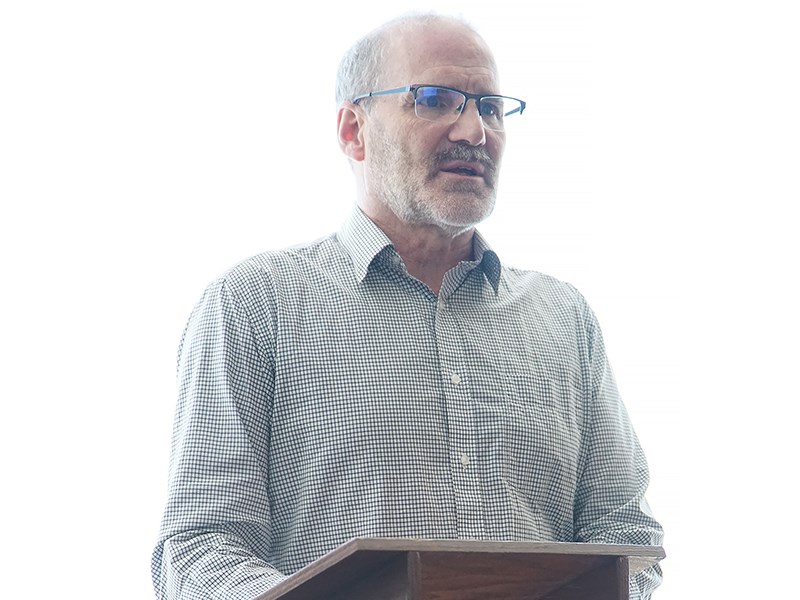Progress on the design of City of Powell River’s consolidated liquid wastewater treatment plant was reviewed by mayor and council at a special committee of the whole meeting on Monday, April 29.
At the meeting, director of infrastructure Tor Birtig said the committee was receiving an update on the state of the design of the consolidated wastewater treatment plant, of which the design is nearing completion.
Birtig said the city submitted an application for funding for construction of the plant a number of months ago, but the city has yet to hear a final decision on funding, which is expected in June. Total project cost has been estimated at close to $80 million, and the city is hoping for a maximum federal/provincial grant of $55.7 million.
“We are hoping a positive decision is coming soon,” said Birtig.
He said the design element for the wastewater treatment plant has been worked on for a couple of years now, and he wanted to bring the committee up to date on the state of the project, and show the design of the plant and steps that have been taken in the design process.
Tom Robinson, project manager for Associated Engineering (BC) Ltd., the design firm hired by the city, said the plant was being constructed to be in compliance with federal and provincial regulations. It will help consolidate the city’s three non-compliant wastewater facilities into one standalone plant. Robinson said the new facility will reduce the environmental impact of wastewater treatment in Powell River.
“We are doing this to make the environment better, to improve human health and to make your operations easier to operate, maintain and administer,” said Robinson. “We are using treatment processes and equipment that are effective, proven, modern, and what we believe offers best value for the city.”
There will be four new pump stations and new conveyance routes, which means pipelines to move wastewater from Westview to Townsite, and also to connect Wildwood to the Townsite system. The Wildwood lagoon will be decommissioned, as will the Westview plant and existing Townsite treatment plant.
In March of last year, the city asked Associated Engineering to work up possible themes for the treatment plant, and eventually selected the natural integration theme, which was a design that integrates the facility into the natural environment and blends in as much as possible with the surroundings.
Showing some images to the committee of the whole, Robinson said what was noticeable was that upon the roofs of three of the buildings, there are green roofs, which feature natural grassy vegetation to help soften the landscape and blend in.
In terms of processing wastewater, Robinson said when wastewater arrives at the plant, it goes through screening and de-gritting, which removes a lot of materials that can be problematic downstream. Then there is secondary treatment, featuring an aerobic-activated sludge system. More than 90 per cent of the treatment systems around the world use one form of this, he added.
“It’s a tried and true system, and also, when it’s done in a modern way, it’s a very effective modern system as well,” said Robinson.
The water then goes through a secondary clarifier and ultraviolet disinfection prior to discharging through a new effluent system and diffuser, which is about 60 metres deep, just off of First Beach.
Robinson said the planned effluent pipeline is about one and a half to two times the length of the jetty by the existing Townsite wastewater plant, so the outfall is quite far out.
There is a commitment in this project to odour control and it has been a key consideration in the design of the plant, said Robinson.
“Foul air from raw wastewater and odorous processes will be contained and treated with the best available odour technology,” said Robinson. “Solids produced in the treatment process will be aerobically digested prior to being dewatered and transported offsite. Aerobic oxygenated processes will provide high efficiency biological treatment without causing odours.”
Robinson said Associated Engineering was presenting a 90 per cent design review of the project at the committee meeting.
Councillors were then taken on a tour of the plant through a 3D design software presentation that was projected onto a screen in council chambers.
Councillor Jim Palm asked about the lifespan of the facility and was advised the lifespan of equipment, such as pumps, was 15 to 20 years, and the concrete lifespan was upwards of 75 years.
Mayor Dave Formosa asked about the capacity for the treatment plant to handle population growth. He was told the plant could accommodate a population of 20,000 before “breaking a sweat.”



